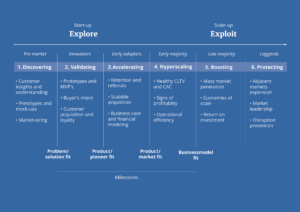As an entrepreneur, it’s essential to understand whether your product or service aligns well with the needs and desires of your target market. This alignment is known as product/market fit. Achieving product/market fit indicates that customers eagerly adopt your offering without extensive sales efforts. In this article, we’ll delve into the concept of product/market fit, explore the metrics for measuring it, and provide strategies to help you attain this crucial milestone.
What is Product/Market Fit?
Product/market fit refers to the point at which your product perfectly satisfies the demands of the market it serves. When you have achieved product/market fit, customers find value in your product, leading to increased adoption and organic growth. It signifies that you have found the right balance between your product and the market’s needs, positioning your business for success.
The Importance of Product/Market Fit for Startups
Product/market fit is vital for startups seeking sustainable growth and scalability. It acts as a foundation for exponential growth, allowing you to attract and retain customers more effectively. Without product/market fit, you may struggle to generate sufficient customer value, face challenges in customer acquisition and retention, and encounter difficulties in scaling your business due to the high customer acquisition costs.
Metrics for Measuring Product/Market Fit
To measure product/market fit, you need to assess three specific metrics that indicate low costumer acquisition costs and high lifetime value. Here are three key metrics I’ve learned to use:
1. Usage
Usage refers to the average utilization of your product or service by customers within a given period. It provides insights into how frequently and extensively customers engage with your offering. By monitoring usage patterns, you can gauge the level of customer satisfaction and identify opportunities for improvement.
2. Retention
Retention measures the number of customers who make repeat purchases. It highlights the ability of your product to retain customers and indicates whether it delivers long-term value. Higher retention rates signify a stronger product/market fit as customers find ongoing utility in your offering.
3. Reference Growth
Reference growth measures the number of customers acquired through word-of-mouth advertising or referrals from existing customers. It indicates the extent to which your satisfied customers recommend your product to others. A growing number of references suggests that customers perceive your offering as valuable and are willing to advocate for it.
Wrong Metrics
When assessing product/market fit, it’s crucial to avoid relying on the wrong metrics that may lead to inaccurate conclusions. Here are some commonly used metrics that do not provide a true indication of product/market fit:
- Revenue: While revenue generation is an important aspect for growth, it does not determine product/market fit. A high revenue does not guarantee that your product achieving sustainable scalability.
- Net Promoter Score (NPS): NPS is a widely used metric to gauge customer satisfaction and loyalty. However, solely relying on NPS can be misleading when measuring product/market fit. While a positive NPS score indicates customers’ willingness to recommend your product, it doesn’t necessarily reflect the product’s perfect fit for the market.
- Interest and Publicity: Measuring interest and publicity through metrics like website traffic, social media engagement, or media mentions can provide some insights. However, these metrics alone cannot accurately determine product/market fit. Interest and publicity might generate initial attention, but it’s essential to assess whether customers find enough value in your product to drive exponential growth.
- Number of Employees: The number of employees in your startup may give an indication of its scale, but it doesn’t directly reflect product/market fit. Growth in team size says more about how much money you are willing to spend instead of how scalable the startup really is.
- Large Investment Rounds: A substantial investment round may provide financial resources to fuel growth, but it does not inherently signify product/market fit. Raising funds is essential for scaling, but it’s crucial to assess the viability and scalability of your product independently.
When measuring product/market fit, it’s important to focus on metrics that directly reflect scalability. Metrics such as usage, retention, and reference growth provide valuable insights into how well your product resonates with the market and whether customers are actively adopting and recommending it without extensive sales efforts. By prioritizing these relevant metrics, you can gain a more accurate understanding of your product’s alignment with the market, lower customer acquisition costs, increase lifetime value and make informed decisions to drive exponential growth.
Determining The Required Percentage
On average, achieving 50% usage, retention, and reference growth is considered a key indicator of product/market fit within a specific market segment. In the context of a smaller segment, such as 0.5% of the total addressable market (TAM), which hypothetically consists of 1 million unique customers, validation may be necessary from approximately 500 customers.
To determine product/market fit, it would be ideal to have around 250 out of these 500 customers consistently making repeat purchases, actively using the product and referring others. This level of engagement signifies a strong alignment between your product and the market’s needs. However, it’s important to note that achieving product/market fit is not an exact science and can vary based on factors like industry, business type, and market size.
The specific ratio required for product/market fit will depend on various factors, and unfortunately, there isn’t a universal formula. It’s essential to evaluate your product’s performance within your target market and aim for a substantial percentage of customers who demonstrate ongoing usage, referral and repeat purchases. This indicates a favorable fit between your offering and the needs of your customer base, signaling a positive trajectory towards achieving product/market fit.
Strategies to Achieve Product/Market Fit
Attaining product/market fit requires a systematic approach. Here are some strategies to help you on this journey:
- Customer Development: Focus on understanding your customers and their needs from the early stages of your startup. Identify a small customer group that shares similar problems and develop a solution that addresses their pain points.
- Validation and Interviews: Validate your assumptions about your target audience and the problem you’re solving through interviews and feedback. This process helps you refine your offering and ensures it resonates with your target market.
- Intensive Product Usage: Aim to create a product that customers use extensively and repeatedly. By providing value and fulfilling their needs consistently, you increase the likelihood of achieving product/market fit.
- Positive Word-of-Mouth: Foster a loyal customer base that actively promotes your product through positive word-of-mouth. Encourage satisfied customers to recommend your offering to others, expanding your customer network and driving growth.
- Iterative Improvement: Continuously gather customer feedback and iterate on your product based on their needs and preferences. This iterative approach allows you to fine-tune your offering and improve its alignment with the market.
What if You Haven’t Reached the 50% Mark?
Achieving product/market fit is often a challenging and time-consuming process, and many startups never reach this milestone. If you haven’t attained the 50% alignment with the metrics, consider the following steps:
- Focus on the Earlyvangelists: Identify the “earlyvangelists” who have a pressing problem that your product solves. These customers are more likely to embrace your offering and provide valuable feedback for improvement.
- Narrow Your Market Segment: Initially, concentrate on a smaller segment of the market to validate your product. By targeting a specific group with a higher likelihood of product/market fit, you can gather more accurate insights and refine your offering accordingly.
- Make Adjustments: If your product isn’t achieving the desired alignment, consider making pivots or adjustments in your business model. Stay flexible and iterate until you find the right product/market fit that resonates with your target audience.
- Refine Your Value Proposition: Evaluate your value proposition and ensure it aligns with the needs and desires of your target market. Identify areas where you can enhance the value your product offers to increase its appeal and relevance.
- Strengthen Customer Relationships: Focus on building strong relationships with your existing customers. Engage with them regularly, seek their feedback, and incorporate their suggestions into your product development process. Cultivating customer loyalty can lead to increased retention and advocacy.
FAQs
Q1. How long does it take to achieve product/market fit?
The time required to achieve product/market fit varies for each startup. It can range from several months to several years, depending on factors such as industry, market size, and the level of customer understanding.
Q2. Is product/market fit a one-time achievement?
Product/market fit is an ongoing process. As your business evolves and the market changes, you may need to revisit and refine your product/market fit strategies to ensure continued alignment with customer needs and market dynamics.
Q3. How much customers do I need to acquire to achieve product/market fit?
The number of customers needed for product/market fit varies based on market size, industry, and business goals. On average, a common benchmark is around 50% usage, retention, and reference growth within a specific market segment. For example, in a hypothetical market of 5 million unique customers, validation for product/market fit may require approximately 5000 customers, of which 2500 are using the product extensively, referring new customers and making repeat purchases.
Q4. Should I invest in marketing and sales before product/market fit?
Investing heavily in marketing and sales before product/market fit can lead to acquiring dissatisfied customers, hindering acquisition and retention. Prioritizing customer development early on is vital. Identify a small customer group facing a common problem, sharing buying motives, and willing to pay for your solution. Build a loyal customer base through word-of-mouth referrals. After achieving product/market fit within this segment, optimize marketing and sales to reach a broader audience efficiently.
Conclusion
Product/market fit serves as a crucial milestone for startups, enabling sustainable growth and success. It is essential to align your product with market needs to effectively attract and retain customers, fostering organic growth and scalability. Measuring product/market fit through metrics such as usage, retention, and reference growth provides valuable insights into your product’s performance and market acceptance.
In the pursuit of product/market fit, it is important to exercise caution and avoid scaling too quickly. Scaling prematurely without achieving a strong product/market fit can lead to challenges and setbacks. It is crucial to focus on understanding your customers, refining your offering, and addressing their needs before pursuing rapid expansion.
By resisting the urge to scale too fast, you can ensure that your product is well-aligned with the market, optimizing customer satisfaction and loyalty. Taking the time to solidify your product/market fit foundation sets the stage for exponential growth and positions your startup for long-term success.
Remember, achieving product/market fit is an iterative process that requires continuous improvement and customer-centricity. Stay dedicated to understanding your earlyvangelists and refining your value proposition to maximize your chances of success in the market.




